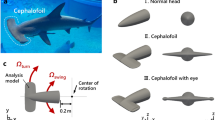Abstract
The propulsion methods of the aquatic lives are the results of optimization by evolution and are useful for the design of swimming-robot, etc. Among them, loach has unique propulsion technique both bending its long body and shaking caudal fin. Our purpose of the research is to clarify its swimming mechanism through flow field analysis. Two dimensional motion and flow around it have been experimentally visualized by particle image velocimetry (PIV). Vortices around a loach and the interactions between the loach body and surrounding water are analyzed. Generating and growing vortices by bending its body, it pushes water backward to gain repulsing force, and it seems that moves through vortices reducing the resistance force at the same time. When a vortex reaches to the caudal fin, it accelerates both sides of the vortex pushing water backward and seems gaining propulsion utilizing the caudal fin. After moving forward, loach leaves a vortex street like reverse Karman vortices, which means that loach gains propulsion.
Similar content being viewed by others
References
Azuma, A., Biokinetics of Flying and Swimming (1992), Springer-Verlag.
Bainbridge, R., The speed of Swimming of Fish as related to Size and to the Frequency and Amplitude of Fin Beat, J. Exp. Bio., 35 (1958), 109–133.
Bartol, I. K. et al., Hydrodynamic stability of swimming in ostraciid fishes. J. of Experimental Biology, 206 (2002), 725–744.
Heltel Heinrich, Bioengineering, translated by Tsuchiya, (1963), Asakura Book.
Kim, M. C., Mori, K., Doi, Y. and Xu, Q., A Numerical Study on Propulsive Force by Contractive and Dilative Motion in Highly Viscous Fluid, Japanese J. of Ship Eng., 183 (1998), 27–33.
Lauder G. V. et al., Experimental hydrodynamics and Locomotion, Inter. Comp. Biol., 42, (2002), 1009–1017.
Lighthill, M. J., Hydromechanics of Aquatic Animal Propulsion, Annu. Rev. Fluid Mech., 44 (1970), 265–301.
Nagayama, K. and Tanaka, K., Analysis of flow field around a moving loach by PIV method, The 6th KSME-JSME Thermal and Fluids Engineering Conference, (2005), FH. 03 CD-ROM.
Wu, T. Y., Hydromechanics of Swimming of Fishes and Cetaceans, Adv. Appl. Mech., 11 (1971), 1–63.
Author information
Authors and Affiliations
Additional information
Katsuya Nagayama: He received his M.Eng degree in Mechanical Engineering in 1988 from University of Tokyo. He also received his Ph.D. in Mechanical Engineering in 1996 from Drexel University. He worked in Yokohama Research Laboratory in Sumitomo Electric Industries Ltd from 1988 to 2002. He works in Dept. of Mechanical and Information Science and Technology, Kyushu Institute of Technology, as an associate professor since 2003. His research interests are Visualization, PIV, Particle Simulation, and Optical fiber.
Kazuhiro Tanaka: He received his Dr. degree in Mechanical Engineering in 1983 from the University of Tokyo. He works in Dept. of Mechanical and Information Science and Technology, Kyushu Institute of Technology, as a professor since 1999. His research interests are Visualization, PIV, Turbo machinery, Vortex flow, and Bond graph.
Rights and permissions
About this article
Cite this article
Nagayama, K., Tanaka, K. 2D-PIV analysis of loach motion and flow field. J Vis 9, 393–401 (2006). https://doi.org/10.1007/BF03181778
Received:
Revised:
Issue Date:
DOI: https://doi.org/10.1007/BF03181778




